Thomas R Morrison
Paranormal Adept
These time-related topics came up in The Extraterrestrial Hypothesis : Fact and Fallacy thread because I think it’s likely that most ufos are genuine spacetime vehicles. If they’re exploiting a gravitational field propulsion system, which very much appears to be the case, then that’s spacetime technology by definition. So in this thread we can focus on the time component of that equation, and perhaps a kind mod would be willing to transfer our time discussions from the ETH thread to this one =)
Everyone finds time to be a fascinating subject, and nearly everyone has their own ways of thinking about time, so here’s a thread where we can talk about all of our time-related notions.
I’ll start by responding to Usual Suspect’s recent post about time in the ETH thread, so we can seamlessly transition the topic into this spin-off thread:
Given the high-precision successes of special relativity and general relativity with regard to time, I consider time to be a dimension that’s different from, but in many ways equivalent to, space. And I find this model to be very intuitive: just as space is measured by the physical interval between two points, time is measured by the temporal interval between two events, and in fact the two can be defined interchangeably using the speed of light C as the conversion constant.
In relativity, 1 second is equivalent to 3x10^8 meters, just as 1 gram is equivalent to 9x10^20 ergs.
But I think that what clinched it for me – this equivalence between space and time, is the incredibly elegant relationship between space and time in special relativity that I stumbled across while studying the science books by Daniel Fry, the controversial alleged contactee. Here's his diagram illustrating a similar relationship between mass and energy:
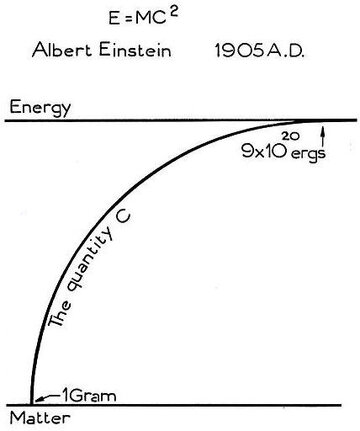
The relationship between the rate of time (second/second) and speed (meter/second) defines a perfect circle. This is the Lorentz transform, which is the central geometrical concept at the heart of the special theory of relativity:
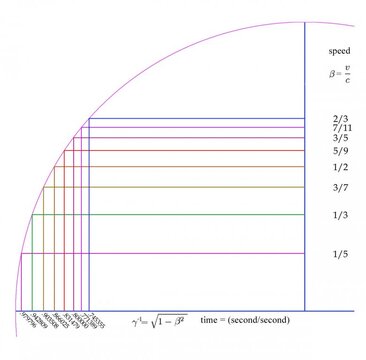
Note that we can substitute the rate of time (second/second) on the x-axis, with the scale of space (meter/meter), to get the length contraction associated with the same speed:
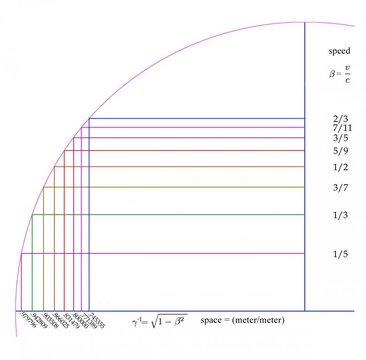
To me, this is unassailable mathematical and geometrical proof that time and space are equivalent physical dimensions. So we can describe them interchangeably: we can talk about a length of time, and measure that length in either seconds or meters. Similarly, we can talk about space in units of meters or seconds, or even years aka “light-years” in common parlance.
So in my mind, the issue is settled: time is a physical dimension that’s equivalent to the spatial dimension - just as objects are arranged in space, events are arranged in time, and the two can be described interchangeably. Therefore objects can be moved around in time and space in any manner permitted by physical law.
Everyone finds time to be a fascinating subject, and nearly everyone has their own ways of thinking about time, so here’s a thread where we can talk about all of our time-related notions.
I’ll start by responding to Usual Suspect’s recent post about time in the ETH thread, so we can seamlessly transition the topic into this spin-off thread:
Time travel does seem counterintuitive to us, but we really do have to reckon with it in real-world terms – here’s a mundane example that we absolutely know is real: the twin paradox (it’s not really a paradox, btw – it’s just kinda strange).
I think most people already know the scenario: an astronaut departs from the Earth and travels in space near the speed of light for awhile, leaving his identical twin brother behind on the Earth. The traveling astronaut twin is traveling through space at relativistic speed, which slows his rate of motion through time relative to his initial rest frame at the Earth (this conjoined space and time geometry is the key feature of special relativity). So when he gets back to the Earth, his brother is an old man, but only some smaller interval, perhaps mere days, have passed for the travelling astronaut twin. It seems unrealistic to our human intuition that a pair of identical twins could end up at different physical ages, standing side by side, simply by moving one of them through space at a high rate of speed, but it’s an absolutely proven scientific fact that this actually happens in physical reality. And gravity has the same effect of aging you more slowly, just like high-speed travel does.
Right. I get all that. But relative changes in localized systems involve different frames of reference. It's not really time travel in the sense we're talking about. It's more a time dilation situation. Let me try to illuminate the perspective I'm coming at this from this way: It may take a few steps, and then we can come back to the rest of the points. This is all very interesting, so maybe we'll both have some sort of epiphany ( or end up equally confused ). To make sure we're on the same page, let's start with what we mean by time in the first place. I'll go first:
Time is change, and all measurements of time depend on being able to detect change. So if change can be detected, time necessarily exists. Are we okay with that or do we need to refine that to some extent?
Given the high-precision successes of special relativity and general relativity with regard to time, I consider time to be a dimension that’s different from, but in many ways equivalent to, space. And I find this model to be very intuitive: just as space is measured by the physical interval between two points, time is measured by the temporal interval between two events, and in fact the two can be defined interchangeably using the speed of light C as the conversion constant.
In relativity, 1 second is equivalent to 3x10^8 meters, just as 1 gram is equivalent to 9x10^20 ergs.
But I think that what clinched it for me – this equivalence between space and time, is the incredibly elegant relationship between space and time in special relativity that I stumbled across while studying the science books by Daniel Fry, the controversial alleged contactee. Here's his diagram illustrating a similar relationship between mass and energy:

The relationship between the rate of time (second/second) and speed (meter/second) defines a perfect circle. This is the Lorentz transform, which is the central geometrical concept at the heart of the special theory of relativity:

Note that we can substitute the rate of time (second/second) on the x-axis, with the scale of space (meter/meter), to get the length contraction associated with the same speed:

To me, this is unassailable mathematical and geometrical proof that time and space are equivalent physical dimensions. So we can describe them interchangeably: we can talk about a length of time, and measure that length in either seconds or meters. Similarly, we can talk about space in units of meters or seconds, or even years aka “light-years” in common parlance.
So in my mind, the issue is settled: time is a physical dimension that’s equivalent to the spatial dimension - just as objects are arranged in space, events are arranged in time, and the two can be described interchangeably. Therefore objects can be moved around in time and space in any manner permitted by physical law.
Attachments
Last edited:

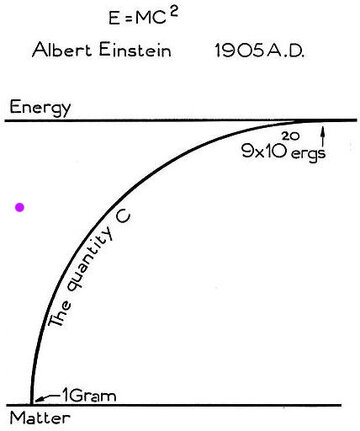
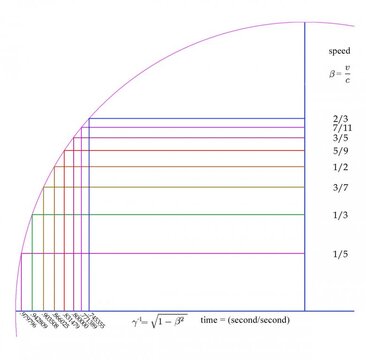


 .
.